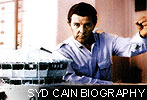Bond Bibles - Raymond Benson
23rd November 2021
Before he was penning Bond fiction, Raymond Benson was the author of the 'Bedside Companion'
Ever since Ian Fleming wrote Casino Royale many authors and journalists have explored and celebrated the James Bond phenomenon. While some books have been official, large format publications, others have delved deeper into specific areas of the subject. In this new series Matthew Field will meet both high-profile writers as well as some of the world’s most knowledgeable “007” experts, who have contributed to the James Bond bibliography.
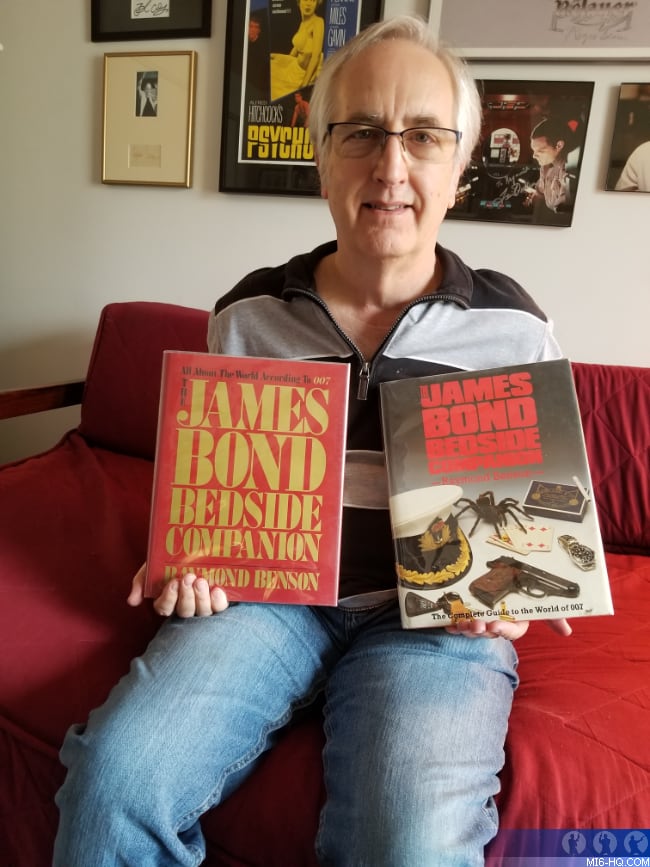
Above: Raymond Benson (From the Raymond Benson Collection, all rights reserved.)
Raymond Benson
– 06 September 1955
Bond Bibles:
- The James Bond Bedside Companion (Dodd, Mead & Company, 1984, Boxtree, 1988)
Bond Novels:
- Zero Minus Ten (Hodder & Stoughton, 1997)
- Tomorrow Never Dies (Hodder & Stoughton, 1997)
- The Facts of Death (Hodder & Stoughton, 1998)
- High Time To Kill (Hodder & Stoughton, 1999)
- The World Is Not Enough (Hodder & Stoughton, 1999)
- DoubleShot (Hodder & Stoughton, 2000),
- Never Dream of Dying (Hodder & Stoughton, 2001)
- The Man With The Red Tattoo (Hodder & Stoughton, 2002)
- Die Another Day (Hodder & Stoughton, 2002).
In 1984, 29-year-old American off-off Broadway director and composer, Raymond Benson wrote his first book, the critically acclaimed, 'The James Bond Bedside Companion'. It soon became and remains a firm favourite amongst James Bond fans and scholars. It was the first ‘Bond Bible’ to encompass both the novels and films in a single volume and was nominated for an Edgar Allan Poe Award for ‘Best Biographical/Critical Work’ by Mystery Writers of America.
During the 1980s Benson designed and wrote computer games, which included two James Bond titles, ‘A View To A Kill’ and ‘Goldfinger’. He also devised the game, 'You Only Live Twice II: Back of Beyond' for Victory Games popular James Bond role-play series. Benson became Vice President of the James Bond 007 Fan Club until its demise in 1990. He contributed various articles to the club’s magazine, Bondage as well as to the British James Bond Fan Club’s magazine, 007. He served on the Board of Directors of The Ian Fleming Foundation from 1995 to 2011.
Matthew Field's Bond Bibles
In 1995 Benson was selected and commissioned by the James Bond literary copyright holders to pen six original 007 novels, three movie novelizations, and three short stories. Post Bond, Benson has continued to write his own original novels including 'The Black Stiletto' saga and to date, is the author of more than 40 books.
It was nearly 40 years ago that Benson began his 007 journey with 'The James Bond Bedside Companion'. With such a successful and varied “Bond” career it would take multiple interviews to cover his entire output. Here, Benson looks back at the book that secured his well-deserved place in James Bond history.
Raymond, how did you discover the world of James Bond?
I grew up in Odessa, a small town in Texas. When I was a kid, I would play with two sisters who lived next door. Their mother was known as M. I don’t know why, maybe her name began with the letter M? One day, I heard this music playing in their living room; it was brassy, loud and cool. I was like, “What is this?” And M said, “Oh it’s that new James Bond movie.” It was the ‘Goldfinger’ soundtrack album. I went home and said, “Hey Dad, we have to go and see 'Goldfinger'!” I was only nine years old and my dad said, “Hmmm….I don’t know about that.” [Laughs]. However, in early 1965, when ‘Goldfinger’ arrived in Odessa, he took me to see it on the big screen and it changed my life.
Why did it make such an impression on you?
I had never seen anything like it. Connery was cool as hell. I was nine and my libido was just kicking in. As you know, I am a film historian and I teach film history. I argue from a pop culture standpoint that ‘Goldfinger’ is the most influential film of the 1960s. It has had so much influence and brought on so much imitation. M next door also had the Ian Fleming Signet paperbacks. At that time Fleming was a number one bestseller. I bought Dr. No that spring and read it. Some of it went over my head but I got the story. And then because the end credits of ‘Goldfinger’ announced ‘Thunderball’ as the next movie I read that one next. And then that summer, ‘Dr No’ and ‘From Russia With Love’ were released on a double-bill. So, I saw the first three movies on the big screen within six months. And Christmas 1965 was when a lot of the merchandise was released: the jigsaw puzzles, board games, and action figures. I wanted the attaché case but that sold out very quickly. It was Bondmania for sure. By the mid 1970s, when I was in college, I still went to see the movies, but I will admit, I did not have the same enthusiasm for the titles made in those years.
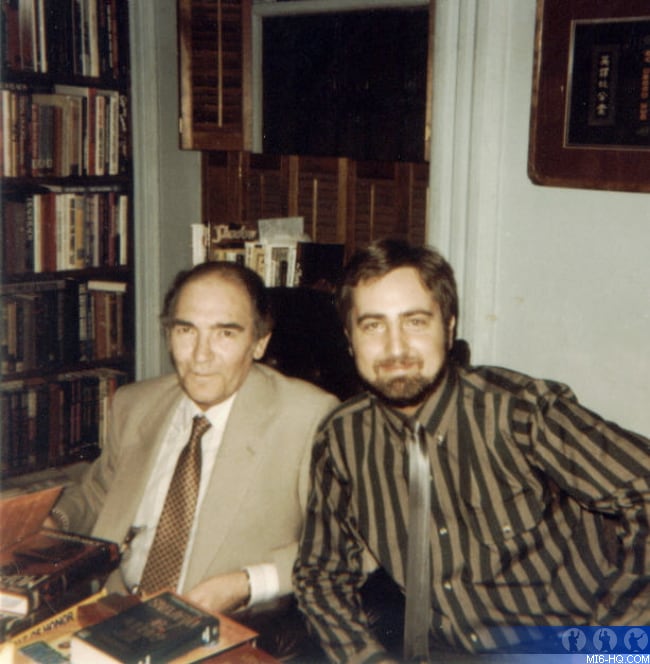
Raymond Benson and John Gardner. (From the Raymond Benson collection. All rights reserved.)
So what reignited your interest in Bond?
I had studied theatre and was living in New York doing off-off Broadway directing plays and writing music. In 1981 two things happened. John Gardner’s first James Bond novel, 'Licence Renewed' was published. It was the first new Bond novel in over a decade. It was kind of exciting. And 'For Your Eyes Only' was released which was more like the earlier films. It was a more serious take on Bond and the screenplay was inspired by Fleming material. I can say that even today it is my favourite Roger Moore Bond film. I got excited, so I started re-reading all the Fleming books again.
What was your inspiration for writing The James Bond Bedside Companion?
That summer - ’81 - I was with some friends and somebody asked the group, “If you had to write a book what would the subject be?” And it came to my turn, and I said, “I would write a coffee table book about the history of James Bond.” They all looked and me and went, “Wow! You should do that!”
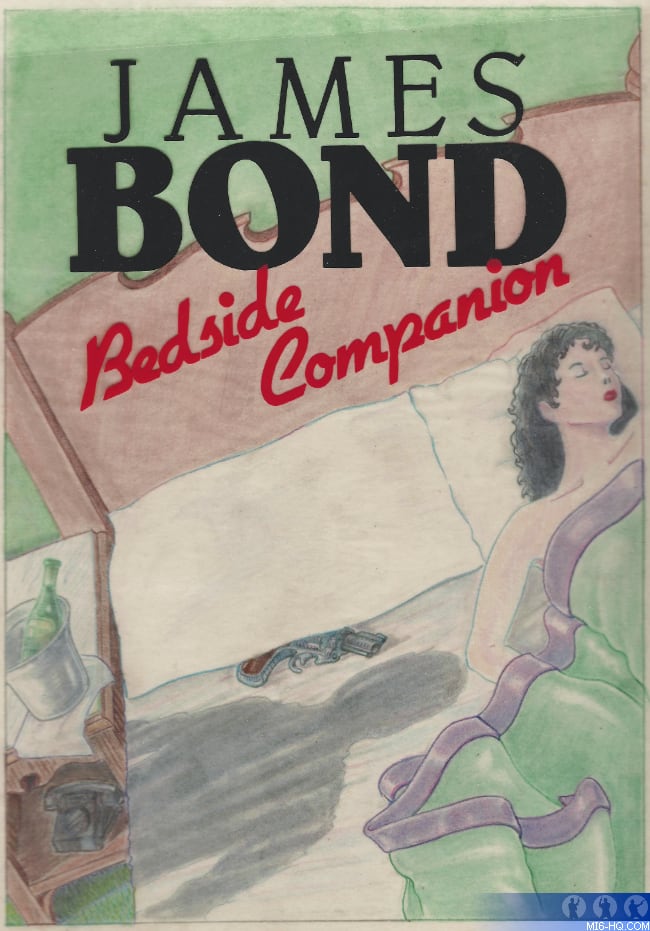
Preliminary concept cover created by a friend, James Goodner, to present to the publisher. (From the Raymond Benson collection. All rights reserved.)
What angle did you want to approach the Bond subject from?
At the time the only books that were available were John Brosnan’s 'James Bond In the Cinema' and Steven Jay Rubin’s 'The James Bond Films', which, had just been published. John Pearson’s 'The Life of Ian Fleming' was out of print. A couple of books had come out in the '60s about the novels, but there was no book that covered everything. I decided I wanted to write a book that was a history, a biography and a critical analysis of both the books and the movies, all in one volume.

Concept cover for Raymond Benson's 'James Bond Bedside Companion (From the Raymond Benson Collection. All Rights Reserved.)
Did you liaise with John Brosnan or Steven Jay Rubin at all?
Yes. I really liked John’s book, it was the first book to deal with the movies and was kind of a revelation when it came out in 1972. We wrote to each other several times but never met in person. He told me what his experiences were and how he went about doing it and he congratulated me when my book was published. Steve gave me some advice on sourcing non-copyright photographs and told me to go to agencies such as World Wide photos, UPI and Associated Press.
You were only in your mid 20s. How did you begin tackling the project?
I didn’t know how to go about writing a book. It was a labour of love! I never thought of myself as a writer at that time. I had a writer friend, Douglas McGrath, who later co-wrote ‘Bullets Over Broadway’ with Woody Allen. At that time Doug had just published a joke book. I told him about my Bond idea. He thought it was great and introduced me to his editor at A&W Publishing, a lady called Ruth Pollock (who incidentally is the sister of the late actor Michael J. Pollard). She told me to write a proposal and what I needed to include. A week later I sent it to her and I got an offer the next day. I didn’t know if it was a good financial deal or not but luckily somebody pointed me in the direction of a literary agent, Patricia Behrens at Sterling Lord Literistic. She looked it over and secured me a better deal.
With a contract in place how did you begin your research?
With the Fleming books. I read them all through and took notes. I focused on the sections you see in my book—Style and Themes, Characters, and Highlights. I wanted to trace the evolution of the character and the writing as the series progressed chronologically. Viewing the films again was more difficult because no one had VCRs in those days except wealthy people and the movies weren’t available yet on VHS. I tried to catch them at repertory cinemas and at one point I travelled to Washington DC and the Library of Congress to view some of the films. The Roger Moore pictures I had seen only once when they first came out and I needed to review them.
Did you contact the James Bond copyright holders, Glidrose and Eon Productions for assistance or support?
I knew I was going to need permission to quote from the novels, so I wrote to Glidrose. I was immediately told “No!” In fact, the reply came from Peter Janson-Smith, the man who I soon learned was Ian Fleming’s literary agent. Peter later became a friend. He would hire me years later to write my future Bond novels. But at the time, my editor said, “Don’t worry about it, keep going.” EON’s reaction was also a flat “No,” coming from their legendary attorney, Norman Tyre. I had written to Glidrose and EON at the same time.
By 1982, Richard Schenkman’s The James Bond 007 Fan Club was firmly established in the United States. Were you aware of Richard and his magazine, Bondage?
Before I had secured the publishing contract, I was doing research and I discovered there was a Bond convention—at least I seem to remember it was indeed a “James Bond fan convention” and not a generic convention (held in October 1981) in New York City. I went along and met Richard there at his table. This was the first time I discovered the club. I told Richard what I was doing and he looked at me a little suspiciously, “Oh you’re writing a book about James Bond…” He had probably heard that a million times! [Laughs]. Anyway, I joined the club and kept in touch. By the time I got the contract we had become a lot closer, and in the Spring of 1982, before I went to England on my research trip, he asked me if I wanted to be the club’s Vice President. So, I started writing articles for the magazine and helped him answer the vast volume of fan mail.
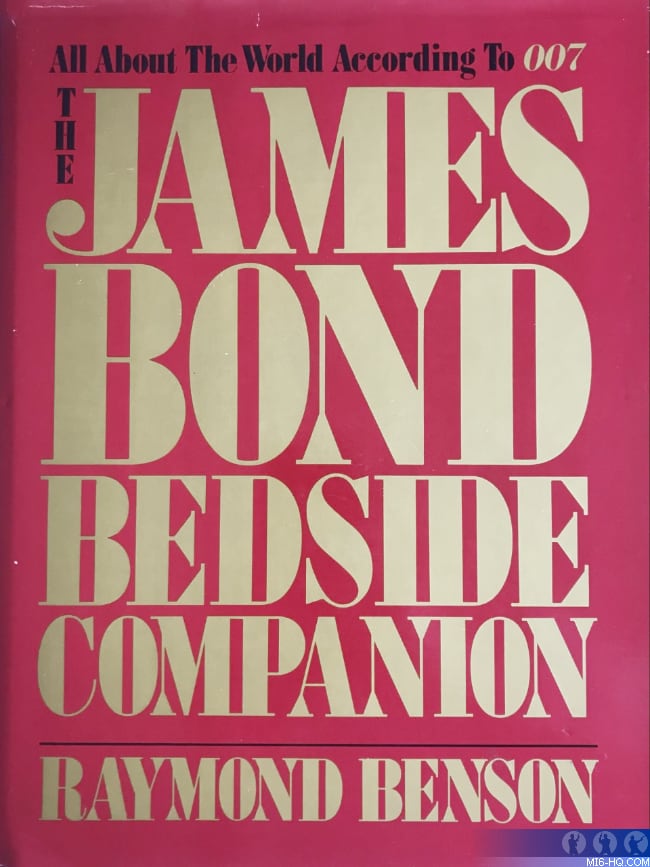
US cover art for Raymond Benson's 'James Bond Bedside Companion'.
You secured some fascinating interviews with individuals who knew Fleming such as Ivar Bryce, Ernest Cuneo, Clare Blanshard, Kingsley Amis and Fleming’s stepdaughter, Fionn Morgan. In the pre-Internet age how did you find these people?
By re-reading John Pearson’s book I noted names, but I didn’t know how to reach these people. One of them was Al Hart who was Fleming’s American editor of the first six Bond novels at Macmillan. As I’ve said, I was living in New York and Macmillan was in New York. I asked them if they could put me in touch with Hart. He was actually still working, at that time, as an agent. So, Al was the first person I interviewed and we talked about some of the things he had to change in the manuscripts when the books were published in the States. Live and Let Die went through a lot of censorship and Al took out great sections of the early Harlem segment. Anyway, Al really liked what I was doing and said, “Somebody should have done this a long time ago.” He was the one that then gave me Ernest Cuneo’s contact info because they were good friends. He also introduced me to Clare Blanshard, too. Al also helped me reach Naomi Burton, who was Fleming’s American literary agent. It was one big networking operation. I’d contact one person and they’d give me two more contracts. That’s how it worked.
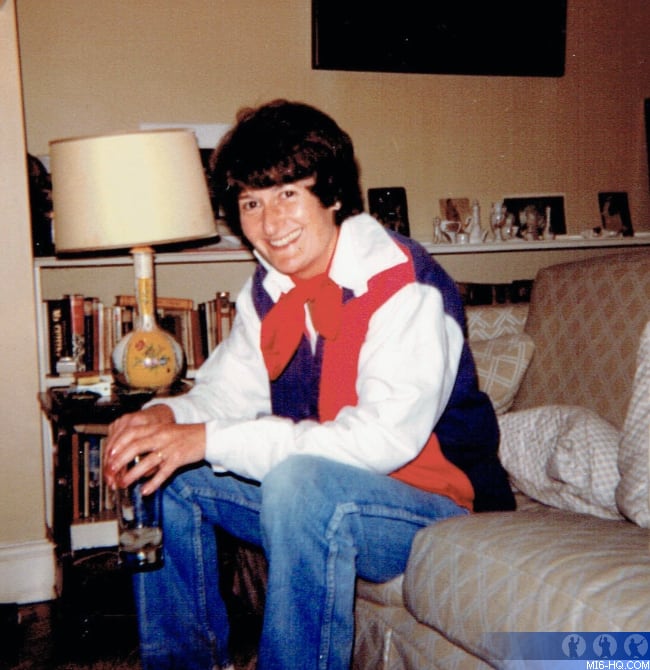
Fleming’s stepdaughter, Fionn Morgan (From the Raymond Benson Collection. All Rights Reserved.)
Let’s talk about the people you met while on your research trip in England during 1982.
Well, let me start with Clare Blanshard. She was so helpful. She secured for me all the contacts on the British side and convinced all those people to talk to me. She knew all of Ian Fleming’s really close friends, including Ivar Bryce. Clare had first met Fleming during the war in intelligence. He was basically her boss. She later worked for Fleming and Ernest Cuneo in New York City. Clare was very fond of Fleming. I included in the manuscript some of her quotes describing him. She really looked up to him.

Raymond Benson with Clare Blanshard (From the Raymond Benson Collection. All Rights Reserved.)
Ann Fleming had died in 1981, a year before your trip but you did meet with Ian’s stepdaughter, Fionn Morgan.
Fionn was very friendly. I really wanted to talk to her about home life, what it was like growing up with Fleming as a stepfather. She said he was always very kind to her and that they got along very well. Fionn said he was very funny and he had a dark sense of humour. And yet, he enjoyed being melancholy--that was his act--being this gloomy, broody guy. I remember Ernest Cuneo (or was it Ivar Bryce?) had told me that one of Fleming’s sayings was “What fun!” But he could say it in different ways that could mean different things! It could be joyous, to mean, “Let’s do have some fun!’…or sarcastic, to mean, “This isn’t fun at all,” and so on. Then there was Robert Harling, also one of Fleming’s closest friends. I had lunch with him and his family at his home and we had a nice long conversation about Fleming. A lot about the war years and his personality. I also spoke on the phone with Nicholas Fleming, Ian’s nephew, who was pretty much the executor of the estate at the time and a member of the Board at Glidrose. I met Nicholas in person a little later after the book was published.
Tell me about meeting Kingsley Amis.
I went to visit him at his home in Kentish Town. He had just broken his foot so he was in a cast. He led me into his office and had his leg up throughout the interview. He was a character, very witty and funny, almost a G.K Chesterson kind of guy. He really liked the early Connery films but couldn’t stand Roger Moore. He said, “The whole thing’s become a cabaret!” [Laughs].
It’s interesting, that like you, Amis also wrote a critical analysis of Fleming’s work, The James Bond Dossier before penning his own Bond novel. Did you ask him about the specifics of his work on completing Ian Fleming’s final novel, 'The Man With The Golden Gun'?
Yes. He said it was already finished. But he did polish it. He made some suggested changes to Fleming’s first draft. He spruced it up and that got him the job of writing Colonel Sun. On my trip I also met a guy called Kenneth Corden who had produced the BBC documentary, Omnibus: Ian Fleming: Creator of the James Bond Myth that was first broadcast in 1970.
You said the Fleming estate turned down your initial request to publish quotes. How did you convince them to cooperate with the Bedside Companion?
Before I embarked on the trip to England I wrote again to Peter Janson-Smith and told him I had interviews set up with Ivar Bryce, John Pearson and Kingsley Amis and could we please meet. I now knew who he was. When I first wrote to Glidrose I did not know his connection to Fleming. I had already written the section of the book that dissected the novels, and I offered to let Peter read it. He said, “Leave it with me and I will read it over the next week while you are here.” At the end of my trip, I went back to his office, he wasn’t there, but he had left a note with my manuscript, which said, “You are doing great work, you have permission to use the quotes and I would like you to keep me updated on how it is going.”
Who could have imagined during those early meetings that 15 years later Janson-Smith would be approaching you with the offer to write an original Bond novel!
I know! I mean, me being a Bond author was never ever on the horizon. It wasn’t even a dream. In those days I never considered myself as a novelist.

Ivor Felix Bryce, Fleming's friend since boyhood. (From the Raymond Benson Collection. All Rights Reserved.)
The cooperation from Fleming’s great friend, Ivar Bryce was a great coup for your book.
Ivar was getting old and dementia was setting in a little bit. But he was still talkative. I stayed with him for a weekend at Moyns Park, which was incredible. He brought out his stack of letters from Ian Fleming. I stayed up all night reading through every one of them and taking notes. Ultimately, the Fleming estate would not let me quote from the letters so I had to paraphrase them. Ivar then put me in touch with his wife, Josephine (Jo). They had an interesting relationship--they were both independently wealthy and each had their own mansions. Jo lived in Vermont in the States at Black Hole Hollow Farm, which was always one of Ian’s stopovers when he was in America. And that is also the setting, which inspired 'The Spy Who Loved Me' and the short story, 'For Your Eyes Only'. I slept in the bedroom that Fleming always slept in there, and it was still the same bed! Jo gave me this incredible photo that she had taken at Ian and Ann’s wedding, which I used in the book. Jo was very bitter about the whole 'Thunderball' case and didn’t want to even talk about it. “That’s what got my husband into trouble!” [Laughs].
Ernest L. Cuneo was another of Fleming’s great friends who was immensely helpful to you…
Oh my gosh, yes! Ernie was living in Washington DC. He took me to his club for dinner when we first met. He was Fleming’s closest American friend, and he was just fantastic and so talkative. We really hit it off and I later asked him when the book was finished if he would write the introduction, which he did. We stayed really close friends until he died in 1988. He would call me every week just to chat. I think he was lonely. I guess, in me, he saw a kindred interest. He loved talking about Ian Fleming. He also talked a lot about Kevin McClory and 'Thunderball' because he was in the middle of all that.
And of course Fleming dedicated Thunderball to Ernest Cuneo.
Well, it was Cuneo who came up with the initial plotline.
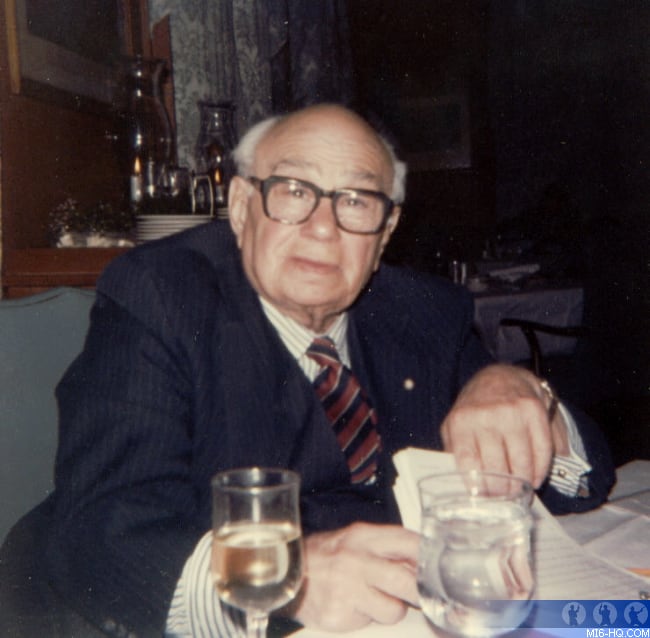
Ernest "Ernie" L. Cuneo, one of Fleming's closest American friends. (From the Raymond Benson Collection. All Rights Reserved.)
On the subject of Thunderball, I understand you did receive cooperation from Kevin McClory.
[Laughs]. Well, kind of. Richard Schenkman had put me in touch. I met him in New York City in the spring of ‘83 before ‘Never Say Never Again’ was released. He was a character, very flamboyant. I then saw him a second time so he could clarify some questions I had sent him, and the meeting took place in the back of his limo, while taking him to the airport. He was very cooperative and nice to me. But later, after the book came out, his lawyer wrote to me and said, “You’ve got things wrong! You will have to reprint the book and make these corrections.” I referred to my notes and I had written exactly what McClory had said. He eventually backed off, and from what I understand, he actually liked the book. Interestingly, I remember his lawyer was called John Lennon.
Did anybody decline to be interviewed?
Well, I wrote to Blanche Blackwell, whom we all now know was Fleming’s long-term “companion” when he was in Jamaica. Blanche replied, “Ian was my neighbour and we were good friends and that is all I have to say.” I should mention Violet Cummings, who was the housekeeper at Goldeneye. We exchanged two or three letters and I remember sending her a questionnaire, and Violet filled out the answers to questions such as ‘What was Ian’s favourite foods?’ etc. She always called him Commander Fleming. I remember she also told me how, for fun, Fleming would purchase cow and donkey carcasses and pitch them in the sea, to watch sharks feed on them. When Fleming describes the sound a shark’s jaw makes in his books, he knew what he was talking about! I wished I could have gone to Jamaica at the time.
In 1970, David A Randall, director of the Lily Library at Indiana University, Bloomington, purchased Ian Fleming’s original manuscripts, letters and notes as well as his collection of antiquarian books from his widow Ann for $150,000. I understand you viewed the collection during your research?
Yes, I spent two days going through that collection before I went to England. I studied his original typescripts, which were all typed on folio paper, 44 lines to the page, double-spaced. Fleming had them all neatly bound in quarter morocco grain cloth of varying colours. The typescripts were all corrected in the author’s handwriting and in many cases, inserts on strange pieces of stationary were bound within as well. To see the original 'Casino Royale' manuscript, to hold the pages Fleming had typed was incredible. Interestingly, a lot of John Pearson’s material for 'The Life of Ian Fleming' was there, too, which had been sold to the library by Leonard Russell who had assisted Pearson on the book. I should mention that all my research material is now in the University of Illinois’ Rare Book and Manuscript Library, thanks to Michael VanBlaricum, President of The Ian Fleming Foundation.
John Pearson told me how he had to be very sensitive when writing his biography of Ian Fleming as it was published just two years after his subject died and many involved were still alive. You wrote The Bedside Companion only 15 years later. Did you have to censor some of your findings and remain discreet?
Well, Ian and Ann Fleming did have a very stormy relationship and you’re right, Pearson only really touches on that because Ann was looking over his shoulder. I started to kind of hint at that and then Fionn Morgan wanted me to soften it, so I did.
By the end of 1982 you had a completed manuscript but the book did not appear until 1984. What was the delay?
I finished the book and then had a shock. The publisher, A&W, suddenly went into Chapter 11 (which under US law means they were about to go bankrupt). So, all their publications were put on hold. My book was supposed to come out late ‘82, early ‘83. Suddenly my book was in limbo and there was nothing I could do. It was devastating and I was really depressed about it. But then in 1983 we got two more movies, 'Octopussy' and ‘Never Say Never Again.’ I was in touch with my editor all this time and she said, “You should keep writing the book. Keep adding to it.” Finally, at the beginning of 1984, A&W sold a lot of their properties and Dodd Mead bought my book. It was a blessing because they were a much better publisher. The editor I had there, Cynthia Vartan, was just great. The manuscript was beta-read and edited by a good friend, Stuart Howard, who helped me get the thing in shape prior to my turning it in to A&W, but Cynthia did the publisher editing, which in truth, didn’t amount to much. Nothing was deleted. She was mainly helpful with the layout and organisation of the material, and very supportive of what I was doing.
You created your own James Bond grammar by using capitals for book titles and italics for film titles, i.e.: GOLDFINGER, Goldfinger. It’s a rule which many Bond fanzines and books continued with, including Ajay and I with Some Kind of Hero.
I knew it would be confusing, so I made that rule up early on. There had not been a book prior to mine, which had discussed the books and the movies together. And it worked.
You have some great photos in the Fleming section, which you credit to a Mary Slater…
I met Mary in England. She was a journalist who had written about Fleming in 1964 while he was writing 'The Man With The Golden Gun'. She visited him in Jamaica and had taken a photographer with her, but she owned the photos. She sold me all the rights and I have since sold them to Mike VanBlaricum. There was a whole series of photographs of Fleming at Goldeneye, more than I could use for the book. I had been given an advance, but it was not much. I spent it on the photos and the quotes.
What was your inspiration for the title?
When I first conceived the project, it was called 'The World According to James Bond' and that's the title on the original contract with A&W Publishing. As 1982 went on and the book was being researched and written, at some point it got changed. I can't remember if the publisher suggested that I come up with a better title or if it was my idea to do so, but at the time there were other books coming out with 'Bedside Companion' in the title. These were usually anthologies of short stories. It struck me that 'The James Bond Bedside Companion' would be cool title, a sort of nudge-nudge, wink-wink play on the character. I suggested it to the publisher and they loved it, so it stuck.
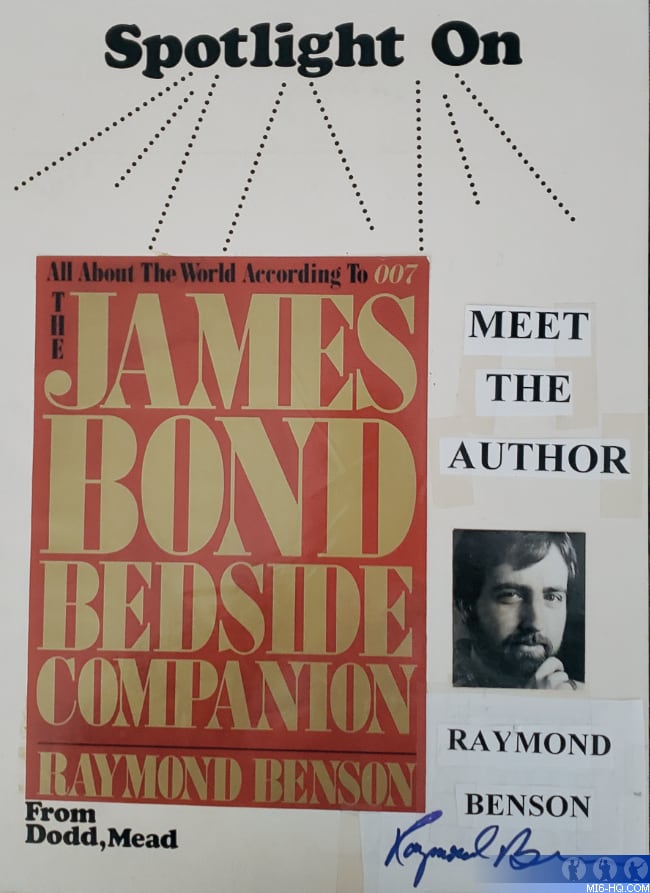
Signing event to celebrate the launch of the 'James Bond Bedside Companion'.
Dodd Mean finally published the book in November 1984. Did you have an official launch?
Yes, I had a book signing at the famous Mysterious Book Shop in Manhattan alongside John Gardner who was signing his latest Bond novel, 'Role of Honour'.
MF: You were somewhat critical of John Gardner’s work in The Bedside Companion and suggested his books were like McDonald’s fast food. Has that comment ever come back to bite you? [Laughs].
Certainly! In fact, John Gardner and I talked about it. In the early '90s I did a big interview with him for 007 Magazine. He invited me out to Virginia for the weekend, where he was living back then. He was candid and towards the end of the weekend he told me that comment had been hurtful. I apologised. I was in my twenties when I wrote that, when I was just a smart aleck Bond fan trying to write clever critiques. We remained friends, though. After being in the hot seat myself, I can understand how he felt.
The James Bond Bedside Companion was hugely successful, so much so, Dodd Mead approached you to update the book.
Yes, in late 1986 early ’87, when Timothy Dalton was just beginning as Bond.
The revised edition took in the additional four John Gardner novels as well as the films ‘A View To a Kill’ and ‘The Living Daylights’. And it was this 1988 update, which saw the book published in the UK for the first time by Boxtree. The jacket was beautifully designed and photographed by Graham Rye, editor of 007 Magazine and at that time, President of The James Bond British Fan Club. It was a still life design similar to the 1972 Pan paperback editions of the Fleming novels featuring a collection of objects which gave a visual impression of the Bond character such as a box of authentic Moorland cigarettes, a Walther PPK, playing cards and a Commander’s cap. Can you remember how that cover came together?
Graham made the bid himself. Somehow he had contacted Boxtree and offered his services to do the cover. I remember he wrote or called me and said, “Hey guess who is doing your cover!” I was blown away when I saw it and I do own a couple of the pieces in the photograph such as the Penfold golf ball. It’s a great cover.
You’ve mentioned the great feedback from Peter Janson-Smith at Glidrose. Did you ever receive comment from EON as to what they thought of the Bedside Companion?
Saul Cooper, who worked in the publicity department at Eon at the time, liked my book and was very complimentary. I was teaching at the New School in New York City and in the spring of 1989 was running a class on James Bond and through Saul, I invited Michael Wilson to the College. They attended my final class and fielded questions from my students in the classroom.
A transcript of the session was published in Bondage magazine. Have you ever heard if The Bedside Companion sits on the bookshelf of any of the Bond talent or filmmakers?
I sent a copy to Sean Connery and then someone sent me a cutting from Hello! Magazine of the book sitting on Connery’s coffee table! I was like “Oh my God!” I framed it and put it on my wall! George Lazenby told me he has a copy, too. I just found out yesterday that Anthony Burgess was a big Bond fan and he had two copies! I read that in an article published in The New Statesman about his collection of James Bond books.

Sean Connery at home with Raymond Benson's 'Bedside Companion'.
I have to ask you about the interview you secured with Timothy Dalton during the publicity campaign for 'Licence To Kill'…
I had sent Dalton my book and he had acknowledged that he used it for research, so he knew who I was. Dalton and EON were coming through New York on the press tour for Licence to Kill. Now that I had the credentials of having written a comprehensive Bond book, I approached The New York Daily News and asked if I could interview Dalton on their behalf, and they agreed. I had an hour with him at the press junket. I am a theatre person and so is he. I didn’t go in there just to ask, “What’s it like to play James Bond?” We talked about theatre and methods of acting and playwrights! I knew he was also interested in Fleming. We really hit it off and when his handler came in at the end to wrap it up, Dalton asked if we could go on a little longer. In fact, we talked a couple of times on the phone after that. I approached him in the mid 1990s to read the audio book of my first Bond novel, Zero Minus Ten but he said, “That’s too much like hard work!” [Laughs].
Did you ever consider updating the book in the 90s and beyond?
By the time I was writing the Bond novels I couldn’t really update it because it wouldn’t be ethical. As the writer of 'The Bedside Companion' I am in critique mode and since I am now on that other side of the line as one of the official authors, I feel that I cannot critique other writers of the books or films. So, it has to remain a relic of the 1980s! It is available as an e-book and I have written a new introduction but I have not updated it.
We should mention your other Bond work. How did the Bedside Companion open further doors for you?
It set my whole life in a completely different direction. Within a month my agent called me and said, “I’ve got this client who produces video games and they’ve got a licence for James Bond. They want a writer!” I happened to like computer games, so I then wrote games based on 'A View To A Kill' and 'Goldfinger'. These were text-based adventures. Then came the pencil and paper role-playing games, a bit like Dungeons and Dragons, and I wrote 'You Only Live Twice II: Back of Beyond' for Victory Games. At one point I even wrote for Glidrose a James Bond stage play based on 'Casino Royale' but that is another story!
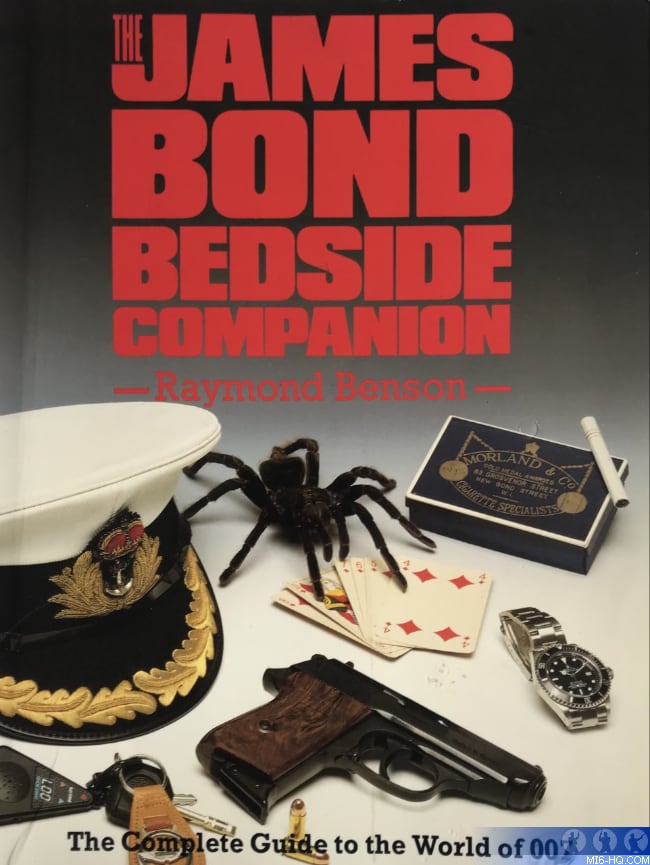
UK Cover art for The James Bond Bedside Companion.
Are you still a Bond fan Raymond?
Yes! I still want to see the movies as soon as they come out. I always read the new novels, it doesn’t matter that I didn’t write them [Laughs]. By the way, it was very heart warming to see that you and Ajay credited and mentioned me in your book.
How do you look back on The James Bond Bedside Companion?
It’s probably going to be the footnote of my life! On the occasion when I post a picture of it on social media there are always Bond fans that will comment, “Bond bible” or “One of my favourite books!” That is gratifying. Were there errors? Of course! Plenty. But I think I’ve corrected all if not most—that I’ve found—in the current e-book version. I was 29 when it was published, and yes, it did open a lot of doors. I wish it had had better illustrative material (better photos), but that’s what I was dealing with at the time. I’m certainly proud of the book, especially the section on the novels. I’ll be forever grateful to all the people who helped me —from Fleming’s family and friends, the late Peter Janson-Smith at Glidrose (now Ian Fleming Publications), my publishers, my own friends, and to all the Bond fans who bought it and have said kind things about it.
Get Bond in Your Inbox
Sign up for occasional email updates from MI6. Get notified of breaking Bond news, and digests of recently releases features:











